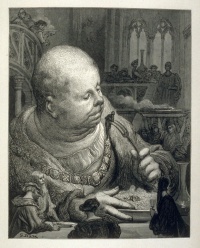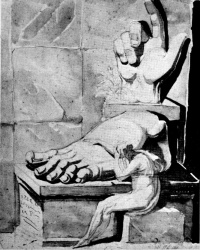Giant
From The Art and Popular Culture Encyclopedia
| Revision as of 20:41, 23 March 2014 Jahsonic (Talk | contribs) ← Previous diff |
Current revision Jahsonic (Talk | contribs) |
||
| Line 1: | Line 1: | ||
| - | [[Image:Roc.gif|thumb|200px|''[[The Roc's Egg]]'' ([[1874]]) by [[Robert Swain Gifford]]]] | ||
| [[Image:Illustration by Gustave Doré, 1873.jpg|thumb|left|200px|'''Gargantua eating six pilgrims''' from ''[[Gargantua and Pantagruel]]'' by [[François Rabelais]], as illustrated by [[Gustave Doré]]]] | [[Image:Illustration by Gustave Doré, 1873.jpg|thumb|left|200px|'''Gargantua eating six pilgrims''' from ''[[Gargantua and Pantagruel]]'' by [[François Rabelais]], as illustrated by [[Gustave Doré]]]] | ||
| - | [[Image:The Shapeless Polyp Floated along the Bank, a Sort of Hideous, Smiling Cyclops (1883) - Odilon Redon.jpg|thumb|right|200px|''[[The Shapeless Polyp Floated along the Bank, a Sort of Hideous, Smiling Cyclops]]'' ([[1883]]) - [[Odilon Redon]]]] | + | {| class="toccolours" style="float: left; margin-left: 1em; margin-right: 2em; font-size: 85%; background:#c6dbf7; color:black; width:30em; max-width: 40%;" cellspacing="5" |
| + | | style="text-align: left;" | | ||
| + | "We think of [[giant]]s as [[Ancient astronauts|occasional visitors to this earth]]. Of course--[[Stonehenge]], for instance. It may be that, as time goes on, we shall have to admit that there are remains of many tremendous habitations of giants upon this earth."--''[[The Book of the Damned]]'' (1919) by Charles Fort | ||
| + | |} | ||
| + | [[Image:Roc.gif|thumb|200px|''[[The Roc's Egg]]'' ([[1874]]) by [[Robert Swain Gifford]]]] | ||
| + | |||
| + | [[Image:The Artist Moved by the Grandeur of Ancient Ruins.jpg|thumb|right|200px| | ||
| + | ''[[The Artist Moved by the Grandeur of Ancient Ruins]]'' ([[1778]]-[[1779|79]]) by [[Henry Fuseli]]]] | ||
| {{Template}} | {{Template}} | ||
| Line 12: | Line 18: | ||
| [[Fairy tales]] such as [[Jack and the Beanstalk]] have formed our modern perception of giants as stupid and violent monsters, frequently said to eat humans, and especially children. However, in some more recent portrayals, like those of [[Roald Dahl]], some giants are both intelligent and friendly. | [[Fairy tales]] such as [[Jack and the Beanstalk]] have formed our modern perception of giants as stupid and violent monsters, frequently said to eat humans, and especially children. However, in some more recent portrayals, like those of [[Roald Dahl]], some giants are both intelligent and friendly. | ||
| ==See also== | ==See also== | ||
| - | *[[Gigantism]] | + | * [[Colossus]] |
| - | *[[Mythology]] | + | * [[Megalography]] |
| - | *[[Giants (Greek mythology)]] | + | * [[Megafauna (mythology)|Giant animal]] |
| - | *[[Colossus]] | + | * [[Giantess]] |
| - | *[[Megalographia]] | + | * [[Giants (Greek mythology)]] |
| + | * [[Giants (esotericism)]] | ||
| + | * [[Gigantism]] | ||
| + | * [[Hindu mythology]] | ||
| + | * [[Nephilim]] | ||
| + | * [[Norse mythology]] | ||
| + | * [[Mythology]] | ||
| + | * [[Standing on the shoulders of giants]] | ||
| + | * [[Titan (mythology) ]] | ||
| {{GFDL}} | {{GFDL}} | ||
Current revision

|
"We think of giants as occasional visitors to this earth. Of course--Stonehenge, for instance. It may be that, as time goes on, we shall have to admit that there are remains of many tremendous habitations of giants upon this earth."--The Book of the Damned (1919) by Charles Fort |
|
Related e |
|
Featured: |
The mythology and legends of many different cultures include monsters of human appearance but prodigious size and strength. "Giant" is the English word commonly used for such beings, derived from one of the most famed examples: the gigantes of Greek mythology.
In various Indo-European mythologies, gigantic peoples are featured as primeval creatures associated with chaos and the wild nature, and they are frequently in conflict with the gods, be they Olympian or Norse.
There are also other stories featuring giants in the Old Testament, perhaps most famously Goliath. Attributed to them are superhuman strength and physical proportions, a long lifespan, and thus a great deal of knowledge as well.
Fairy tales such as Jack and the Beanstalk have formed our modern perception of giants as stupid and violent monsters, frequently said to eat humans, and especially children. However, in some more recent portrayals, like those of Roald Dahl, some giants are both intelligent and friendly.
See also
- Colossus
- Megalography
- Giant animal
- Giantess
- Giants (Greek mythology)
- Giants (esotericism)
- Gigantism
- Hindu mythology
- Nephilim
- Norse mythology
- Mythology
- Standing on the shoulders of giants
- Titan (mythology)



